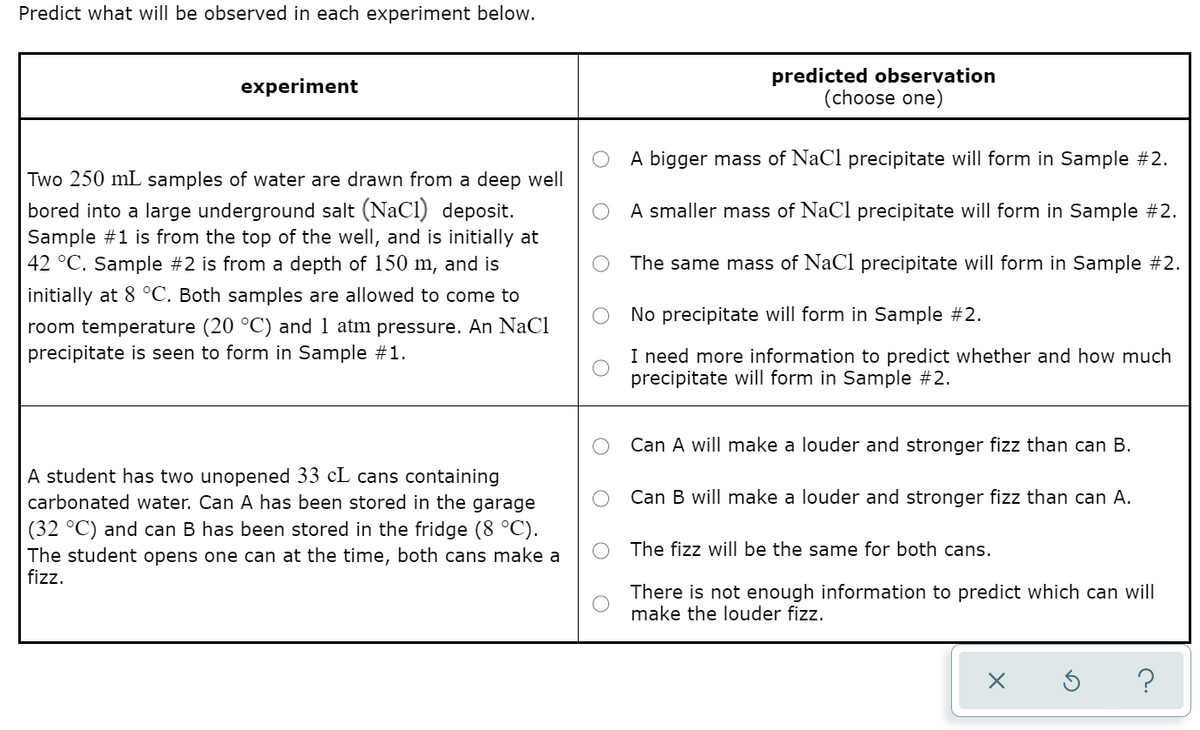Predict what will be observed in each experiment below. predicted observation (choose one) experiment A bigger mass of NaCl precipitate will form in Sample #2. Two 250 mL samples of water are drawn from a deep well bored into a large underground salt (NaCl) deposit. O A smaller mass of NaCl precipitate will form in Sample #2. Sample #1 is from the top of the well, and is initially at 42 °C. Sample #2 is from a depth of 150 m, and is initially at 8 °C. Both samples are allowed to come to The same mass of NaCl precipitate will form in Sample #2. No precipitate will form in Sample #2. room temperature (20 °C) and 1 atm pressure. An NaCI precipitate is seen to form in Sample #1. I need more information to predict whether and how much precipitate will form in Sample #2. Can A will make a louder and stronger fizz than can B. A student has two unopened 33 cL cans containing carbonated water. Can A has been stored in the garage (32 °C) and can B has been stored in the fridge (8 °C). The student opens one can at the time, both cans make a fizz. Can B will make a louder and stronger fizz than can A. The fizz will be the same for both cans. There is not enough information to predict which can will make the louder fizz.
Predict what will be observed in each experiment below. predicted observation (choose one) experiment A bigger mass of NaCl precipitate will form in Sample #2. Two 250 mL samples of water are drawn from a deep well bored into a large underground salt (NaCl) deposit. O A smaller mass of NaCl precipitate will form in Sample #2. Sample #1 is from the top of the well, and is initially at 42 °C. Sample #2 is from a depth of 150 m, and is initially at 8 °C. Both samples are allowed to come to The same mass of NaCl precipitate will form in Sample #2. No precipitate will form in Sample #2. room temperature (20 °C) and 1 atm pressure. An NaCI precipitate is seen to form in Sample #1. I need more information to predict whether and how much precipitate will form in Sample #2. Can A will make a louder and stronger fizz than can B. A student has two unopened 33 cL cans containing carbonated water. Can A has been stored in the garage (32 °C) and can B has been stored in the fridge (8 °C). The student opens one can at the time, both cans make a fizz. Can B will make a louder and stronger fizz than can A. The fizz will be the same for both cans. There is not enough information to predict which can will make the louder fizz.
Chapter1: Solubility
Section: Chapter Questions
Problem 1Q
Related questions
Question
100%

Transcribed Image Text:Predict what will be observed in each experiment below.
predicted observation
(choose one)
experiment
A bigger mass of NaCl precipitate will form in Sample #2.
Two 250 mL samples of water are drawn from a deep well
bored into a large underground salt (NaCI) deposit.
Sample #1 is from the top of the well, and is initially at
42 °C. Sample #2 is from a depth of 150 m, and is
A smaller mass of NaCl precipitate will form in Sample #2.
The same mass of NaCl precipitate will form in Sample #2.
initially at 8 °C. Both samples are allowed to come to
No precipitate will form in Sample #2.
room temperature (20 °C) and 1 atm pressure. An NaCl
precipitate is seen to form in Sample #1.
I need more information to predict whether and how much
precipitate will form in Sample #2.
Can A will make a louder and stronger fizz than can B.
A student has two unopened 33 cL cans containing
carbonated water. Can A has been stored in the garage
Can B will make a louder and stronger fizz than can A.
(32 °C) and can B has been stored in the fridge (8 °C).
The student opens one can at the time, both cans make a
fizz.
The fizz will be the same for both cans.
There is not enough information to predict which can will
make the louder fizz.
?
Expert Solution
This question has been solved!
Explore an expertly crafted, step-by-step solution for a thorough understanding of key concepts.
This is a popular solution!
Trending now
This is a popular solution!
Step by step
Solved in 3 steps with 3 images

Knowledge Booster
Learn more about
Need a deep-dive on the concept behind this application? Look no further. Learn more about this topic, chemistry and related others by exploring similar questions and additional content below.Recommended textbooks for you

EBK A SMALL SCALE APPROACH TO ORGANIC L
Chemistry
ISBN:
9781305446021
Author:
Lampman
Publisher:
CENGAGE LEARNING - CONSIGNMENT

Principles of Modern Chemistry
Chemistry
ISBN:
9781305079113
Author:
David W. Oxtoby, H. Pat Gillis, Laurie J. Butler
Publisher:
Cengage Learning

General, Organic, and Biological Chemistry
Chemistry
ISBN:
9781285853918
Author:
H. Stephen Stoker
Publisher:
Cengage Learning

EBK A SMALL SCALE APPROACH TO ORGANIC L
Chemistry
ISBN:
9781305446021
Author:
Lampman
Publisher:
CENGAGE LEARNING - CONSIGNMENT

Principles of Modern Chemistry
Chemistry
ISBN:
9781305079113
Author:
David W. Oxtoby, H. Pat Gillis, Laurie J. Butler
Publisher:
Cengage Learning

General, Organic, and Biological Chemistry
Chemistry
ISBN:
9781285853918
Author:
H. Stephen Stoker
Publisher:
Cengage Learning

Chemistry: The Molecular Science
Chemistry
ISBN:
9781285199047
Author:
John W. Moore, Conrad L. Stanitski
Publisher:
Cengage Learning

Chemistry & Chemical Reactivity
Chemistry
ISBN:
9781133949640
Author:
John C. Kotz, Paul M. Treichel, John Townsend, David Treichel
Publisher:
Cengage Learning

Chemistry & Chemical Reactivity
Chemistry
ISBN:
9781337399074
Author:
John C. Kotz, Paul M. Treichel, John Townsend, David Treichel
Publisher:
Cengage Learning